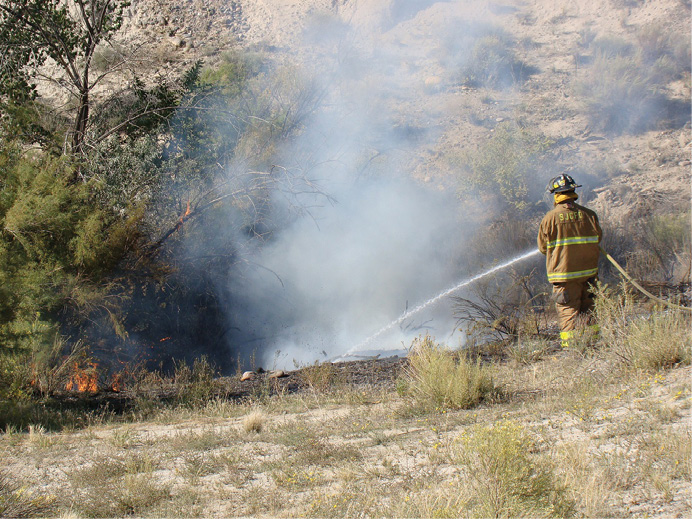
Wildland Urban Interface ❘ By THOMAS W. AURNHAMMER
Structural firefighters operating in a wildland urban interface (WUI) may have to determine which buildings can be saved from an impending wildland fire. That determination can become convoluted from looking at structures within wildland areas with an eye toward employing typical residential fire tactics as well as the emotionally charged pressures from homeowners and elected officials to save these structures. Although you should examine structural triage issues well before a fire occurs, structural fire officers operating at a WUI fire may have to make split-second decisions on which buildings to “write off” and which to protect.
Although there are a number of prevention programs that will increase the fire resilience of homes and structures in the WUI, this article examines structural triage as a component of the initial fire response. Local fire departments should encourage and participate in efforts that improve a community’s coexistence with wildland fires through programs such as the National Fire Protection Association’s Firewise USA®, the International Association of Fire Chiefs Ready, Set, Go!, or the Fire Adapted Communities® resources. If you have WUI areas within your jurisdiction, you have an obligation to educate and inform homeowners about the risks and hazards associated with living in areas prone to wildland fires.
Once again, preplanning and training in wildland fire issues can assist structural firefighters in carrying out tasks related to the triage and protection of structures in the path of a wildland fire. Time is certainly a major factor in this decision making. You will also need to factor in fire behavior from the standpoint of dealing with a fast-moving fire front or flying embers into any incident action plan. The continued exposure to wildland fire training can minimize the potential of miscommunication between wildland firefighters and structural firefighters. Both groups need to understand the expectations of carrying out structure protection as part of the initial fire attack as well as recognizing when any efforts to save buildings will be in vain.

(1) The resources on this incident may be able to address a wildland fire, but they are not prepared to fight a structure fire. (Photos by author.)

(2) Structure turnout gear should not be your first choice in fighting a wildland fire.
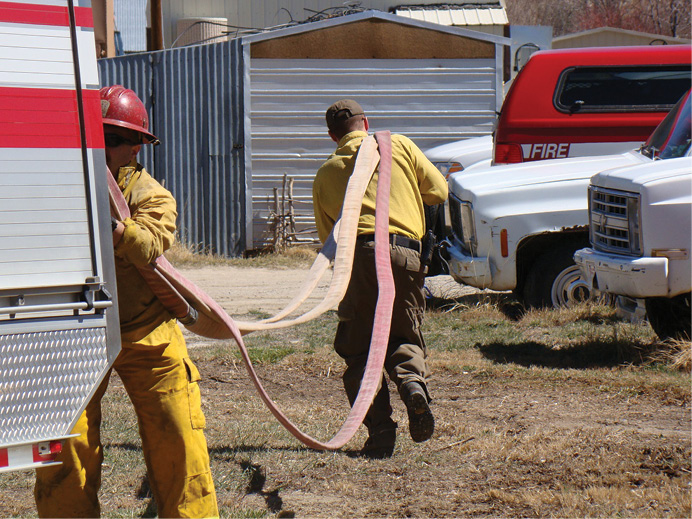
(3) By the same token, do not use wildland fire personal protective equipment when fighting a structure fire.
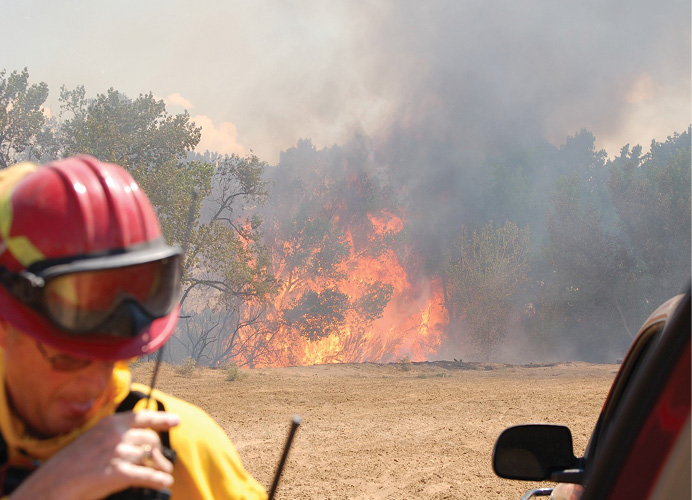
(4) A fast-moving flame front is going to create time constraints in structural triage and mitigating hazards around exposed buildings.
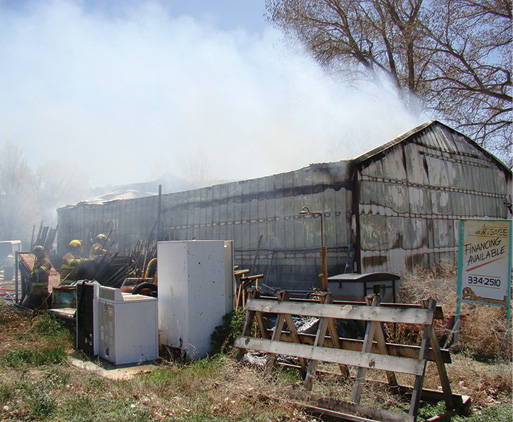
(5) Consider the combustibility of materials around an exposed structure as well as the structure itself in an initial survey.
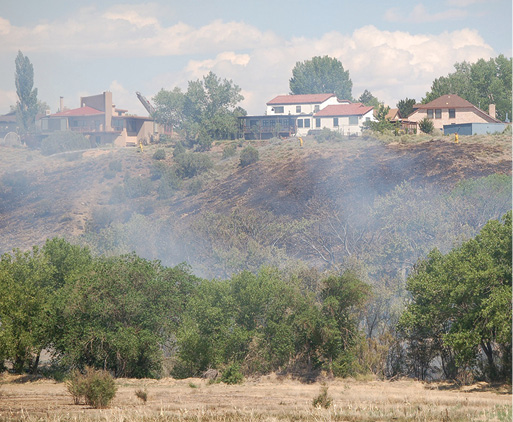
(6) In the S-FACTS acronym for structural triage, the “C” stands for “Construction” and “Clearance.”
RELATED
Incident Safety Officers in the Wildland Urban Interface
We Have to do Something … or Do We?
The natural inclination of any firefighter is to do something to solve the problem at hand. With no training or plan of action in place, the door is open to structural firefighters freelancing and falling back on carrying out familiar actions. In some cases, those behaviors may be inappropriate. One problem in the application of residential fire tactics to a burning home in the WUI is that the wildland fire may continue to grow unchecked, threatening even more structures while firefighters are trying to battle a lost cause. WUI fires need some sort of structural triage, and part of that assessment may include that not all structures can be saved.
Resources. Will you commit all of your initial response resources to a fully involved structure that was the result of a wildland fire? If you are lucky enough to have unlimited resources, that may be the correct strategy. However, most fire departments—especially in rural areas—are short staffed. A WUI fire is going to be an extremely resource-intensive event, and not many fire departments are staffed to handle a wildland fire and a structure fire at the same time.
Wearing proper personal protective equipment (PPE). If you think about it, the acronym “WUI” joins two locales, each with its own inherent fire risk. One issue in responding to an incident in a WUI area is selecting the proper PPE. If a firefighter has donned his wildland PPE and the incident turns into a structure fire, what happens? Was he issued both types of PPE? If so, is his structural PPE on the apparatus?
In a perfect world, firefighters would be issued and carry both structural and wildland gear. However, the world is not a perfect place, and firefighters should not assume the risk of fighting a structure fire in wildland PPE. By the same token, firefighters in structural PPE need to consider the risk of heat-related stresses and injuries that could occur by fighting a wildland fire in that type of gear.
What is the hazard? Are WUI structures being threatened by a fast-moving flame front or exposed to flying embers? These two threats have different origins, each with its own unique hazards. The fire front will create issues with radiated heat, while the embers allow burning materials to travel great distances. Both threats create concerns in how much time firefighters have to perform a structure assessment and attempt to fix problems. If time runs out or fire conditions change, it may be time to make a hasty retreat. Remember to always consider firefighter safety in command decision making at all incidents.
Initial Survey
The initial survey of structures and other exposures in the WUI must include the following considerations:
Triage
- What is the fuel load around the structure?
- Is the structure combustible?
- Can the area around the structure be mitigated in time (e.g., reduce flammable vegetation and/or remove flammable and combustible materials around the exposed structure)?
- Is the structure vulnerable to surface fire and/or flying embers because of combustible roofing material or siding—e.g., wood shakes?
Resources
- How many personnel are on scene?
- Do they have the proper equipment?
- Has a water supply been established?
- Is mutual aid on the way, how many and what types of apparatus, and will it be enough?
Safety
- Is the structure defensible?
- Have safety zones been established?
- Have escape routes been identified?
Structural Triage Checklist
The “S-FACTS” acronym, found in Wildland Urban Interface Operating Principles and published by the California Department of Forestry and Fire Protection (Cal Fire) in 2014, is a great tool for developing a structural triage checklist. S-FACTS, which stands for Survival, Fire environment, Access, Construction/Clearance, Time constraints, and Stay or go, places threatened structures into three categories: (1) not threatened, (2) threatened defensible, and (3) threatened nondefensible. You can also use S-FACTS to prioritize and make determinations about structure defense tactics and resource assignments.
Cal Fire realized that, during a WUI fire, it may be difficult to remember all of the factors that need to be considered during the structure triage decision process. These Survival Facts (S-FACTS) provide a useful memory aid in applying a structure triage tool. A detailed description of “S-FACTS” and the three threatened structure categories can be found in the document.
Lessons from the Esperanza Fire
The Esperanza Fire occurred on October 26, 2006, in Cabazon, California. While providing structural protection, five firefighters from the San Bernardino National Forest Engine 57 died in the line of duty. Pablo Cerda, Mark Loutzenhiser, Jason McKay, Daniel Hoover-Najera, and Jess McLean were caught in a burnover when a wind shift caused the wildfire to spread rapidly.
The United States Department of Agriculture and Cal Fire conducted the investigation into this tragic incident. The first contributing factor identified in the report spoke of culture. The report stated that firefighters exposing themselves to great risk for structural protection tend to be tolerated by the fire service and expected by the public. It also acknowledged the need for a cultural change and paradigm shift in protecting structures in the WUI, which resulted in new ways of thinking along with commensurate training programs, all in the interest of firefighter safety.
When performing a triage of exposed buildings in the WUI, fire officers must make decisions that are not only safe but also effective. Time is a critical factor, and the fact that no building or structure in the path of a wildland fire is worth the life of a firefighter must be at the forefront of any decision. Talk about the structural challenges within your jurisdiction, and develop a triage training program that fits the needs of your department.
THOMAS W. AURNHAMMER is a 43-year fire service veteran, a fifth-generation firefighter, and the chief (ret.) of the Los Pinos Fire District in Ignacio, Colorado. He is a graduate of the National Fire Academy’s Executive Fire Officer Program and has a bachelor of science degree in fire administration. Aurnhammer also has the Chief Fire Office designation and is a member of the Institution of Fire Engineers, U.S. Branch.

